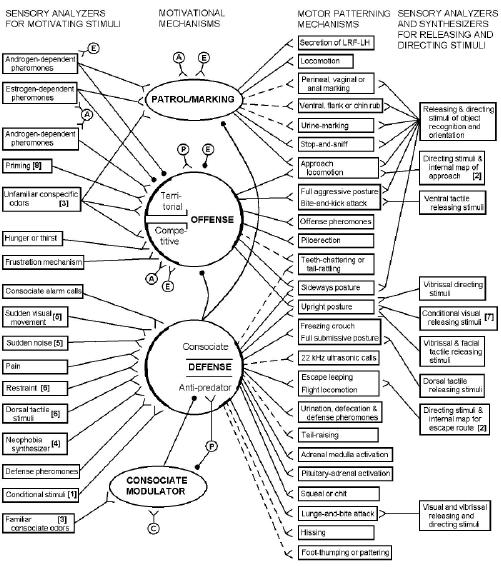Stories
The brain mechanisms of aggression
Motivational systems of social behavior
International Society for Research on Aggression
Behavior Genetics Association Ethics Committee
The World Wide
Runners Club
for Peace
United Nations University for Peace
Charlie Robbins, barefoot runner
* * *
When I returned from the Soviet Union, I decided to concentrate on a research program to understand the brain mechanisms of aggression.
Believing that the basic approach should be firmly rooted in an evolutionary approach, as a first step, I went to the library to learn everything possible about the aggression of rodents, especially the observations of aggressive behavior in wild animal species. I found and studied hundreds of articles, primarily by biologists, and put together an evolutionary analysis of the aggressive behavior of muroid rodents, which was published in 1980 in the journal Aggressive Behavior and is available online. To explain the data, I used a motivational systems analysis.
The motivational systems analysis had been refined in our laboratory by one of my students, Michael Lehman, based on an approach that I had used to explain the data from our laboratory rats as published in a 1975 paper in Behaviour. Michael noted each act of two interacting animals on a moving tape and then fed the data into a computer to determine which sequences were non-random. We then assumed that the non-random sequences represented behaviors controlled by one particular motivational mechanism. The study with Lehman, published in Behaviour in 1977, identified motivational mechanisms for exploration/marking, offense, defense and submission, and indicated several sensory inputs and motor patterning outputs for each of them. This motivational systems analysis provided a basic model that I have been elaborating ever since. The only fundamental changes in the 2006 model shown below is the renaming of exploration/marking as patrol/marking, the inclusion of submission as a special case of defense (consociate defense), and the omission of a motivational mechanism for self-grooming for which we could not obtain supporting data.

Figure from 2006 paper in Neuroscience and Biobehavioral Reviews. For a larger version of the figure, click here.
Between 1979 and 1983 I published three more major review papers on this motivational systems analysis: 1) an analysis of where hormones affect the system; 2) an analysis of the points in the system where learning and related changes take place; and 3) an preliminary analysis of the locations of each pathway and nodal point in the neuroanatomy of the brain. All three are available on line at http://www.culture-of-peace.info/aggression-intro.html . The third analysis was published in Behavioral and Brain Sciences which provided critiques by most of the major researchers in this field. I was very pleased with their comments, as it showed me that the motivational systems analysis was the best analysis available at that time (and, I believe, to the present day). Bob and Caroline Blanchard, perhaps the best of the critics, suggested that submission should not be separated from defense, a suggestion that I came to agree with in my later 2006 review.
The behavioral and brain research in the "ratlab" from 1983 to 1993 (when I closed the lab to go to Paris) were devoted to testing and and elaborating the above motivational systems analysis. In addition to further behavioral, brain stimulation and lesion studies, we developed a method used by my friend Michael Davis at Yale to deliver small amounts of neurotransmitters to selected groups of neurons in the brain. For the first time we were able to elicit offense behavior by targeted stimulation with specific neurotransmitters (this had been done frequently in the past for defense, but never for offense). But as always in research, the experiment raised more questions than it solved. Why could we obtain offense in the hypothalamus but not in the midbrain where certain lesions abolished offense behavior while others intensified the offensive sideways posture?
In 1989 I put together my various papers into a book, The Aggression Systems. Unable to find a publisher after inquiries with major publishing companies, I self-published 50 copies and distributed them to major libraries. Then with the advent of my Internet capabilities I put the entire book The Aggression Systems on line at http://www.culture-of-peace.info/aggression-intro.html.
In 2006 I updated the 1979 review, looking at the 25 years of intervening research. The figure above comes from the 2006 publication. There are only a few changes in the motivational systems model. In particular, both the offense and defense motivational mechanisms were subdivided into similar, but differentiated subsections: territorial and competitive offense; and consociate and anti-predator defense (the latter replacing a previously-postulated submission mechanism). The 2006 publication is available on line at http://www.culture-of-peace.info/update/abstract.html
The full set of all my publications is on line on my personal website.
 |
Stages
1986-1992
Fall of Soviet Empire
1992-1997
UNESCO Culture of Peace Programme